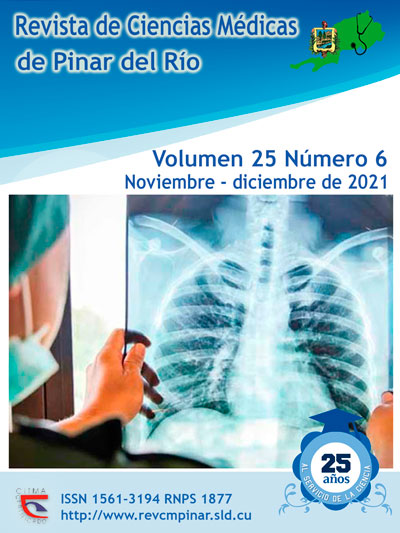Comprehensive teaching aids system for learning Medical Bacteriology
Keywords:
BACTERIOLOGY, MEANS OF EDUCATION, LEARNING.Abstract
Rationale: the syllabus of Medical Microbiology and Parasitology in the subject Medical Bacteriology, addresses contents that students should acquire for a better understanding of the morbid processes studied in the subjects that make up the main integrating discipline.
Objective: to design a comprehensive system of teaching aids for the learning of Medical Bacteriology of the subject Medical Microbiology and Parasitology for second-academic-year students of medicine major at Ernesto Che Guevara de la Serna School of Medical Sciences of Pinar del Río.
Methods: an educational research was carried out, with a target group of 455 second-academic-year students of medicine major during 2019-2020 at Ernesto Che Guevara de la Serna School of Medical Sciences of Pinar del Río, along with 118 professors comprising the teaching staff. The sample included 171 students and 16 professors intentionally chosen. Theoretical, empirical and statistical methods were applied.
Results: it was evidenced that the available teaching aids to students and professors are not effective enough for the teaching-learning process of the subject Medical Bacteriology. The need of students and professors for a comprehensive system of teaching aids for the learning of Medical Bacteriology was confirmed. A comprehensive system of teaching aids for the learning of Medical Bacteriology was devised.
Conclusions: the comprehensive system of teaching aids was considered useful and pertinent by the specialists, due to the updating of its contents and methodological treatment.
Downloads
References
1. Aguayo A. La reforma de nuestra educación . En: C. d. autores. Crítica y reforma universitarias. La Habana: Universidad de La Habana; 2018.
2. Salas Pérez RS. Los medios de enseñanza en la educación en salud”, Biblioteca de Medicina. Vol XXIII. Universidad Mayor de San Andrés, La Paz; 2017.
3. Area M. Los medios, los profesores y el currículo. Barcelona: Sendai Ediciones; 2016.
4. Cabero Almenara J. Medios audiovisuales y nuevas tecnologías de la información y la comunicación en el contexto hispano. In: Aguaded Gómez JI, Cabero Almenara J. Educación y medios de comunicación en el contexto iberoamericano [Internet]. España: Universidad Internacional de Andalucía; 1995. [Citado 11/10/2013]. Disponible en: http://dspace.unia.es/bitstream/10334/1498/1/04Cabero.pdf
5. Marqués Graells P. Los medios didácticos [Internet]. Barcelona: Universidad Autónoma de Barcelona; 2004. [Citado 11/10/2013]. Disponible en: https://orion2020.org/archivo/docencia/05%20Medios%20didacticos.htm
6. Ríos LR, López Rodríguez E, Lezcano Brito M, Pérez R. Historia y evolución de los medios de enseñanza. Revista Iberoamericana de Educación [Internet]. 2006 [cited 12/03/2019]; 37(6): [aprox. 10p]. Disponible en: https://rieoei.org/RIE/article/view/2681
7. Diccionario de la lengua española de la Real Academia Española (DRAE). 22a edición; 2000. p. 89.
8. López Vargas BI, Basto Torrado SP. Desde las teorías implícitas a la docencia como práctica reflexiva. Educación y Educadores [Internet]. 2010 [citado 28/09/2019]; 13(2): [aprox. 17p.]. Disponible en: http://www.scielo.org.co/scielo.php?pid=S0123-12942010000200007&script=sci_arttext
9. Blumenfeld LA. La Dialéctica y los métodos científicos generales de la investigación. TI. La Habana: Editorial de Ciencias Sociales; 2018.
10. Torres Almanza E. Los medios de enseñanza en el proceso de enseñanza aprendizaje. Material didáctico para los estudiantes de enfermería. Filial de Ciencias Médicas “Isabel María Hernández Mayedo” Hospital General- Docente “Guillermo Domínguez López” Puerto Padre; 2019.
11. Díaz Juan FA, Calichs López E. Sistema de medios de enseñanza sobre tronco encefálico y dirección del trabajo independiente. Edu Med Sup [Internet]. 2014 [citado 04/03/2016]; 28(4). Disponible en: http://scieloprueba.sld.cu/scielo.php?script=sci_arttext&pid=S0864-21412014000400002&lng=es
12. Mugarra Romero CG, Pérez Rodríguez H, Bujardón Mendoza A. Consideraciones sobre la educación en valores a través de los medios de enseñanza-aprendizaje. Rev. Hum Med [Internet]. 2011 [citado 30/03/2018]; 11(3). Disponible en:
http://scielo.sld.cu/scielo.php?script=sci_arttext&pid=S1727-81202011000300009&lng=es
Downloads
Published
How to Cite
Issue
Section
License
Authors who have publications with this journal agree to the following terms: Authors will retain their copyrights and grant the journal the right of first publication of their work, which will be publication of their work, which will be simultaneously subject to the Creative Commons Attribution License (CC-BY-NC 4.0) that allows third parties to share the work as long as its author and first publication in this journal are indicated.
Authors may adopt other non-exclusive license agreements for distribution of the published version of the work (e.g.: deposit it in an institutional telematic archive or publish it in a volume). Likewise, and according to the recommendations of the Medical Sciences Editorial (ECIMED), authors must declare in each article their contribution according to the CRediT taxonomy (contributor roles). This taxonomy includes 14 roles, which can be used to represent the tasks typically performed by contributors in scientific academic production. It should be consulted in monograph) whenever initial publication in this journal is indicated. Authors are allowed and encouraged to disseminate their work through the Internet (e.g., in institutional telematic archives or on their web page) before and during the submission process, which may produce interesting exchanges and increase citations of the published work. (See The effect of open access). https://casrai.org/credit/



